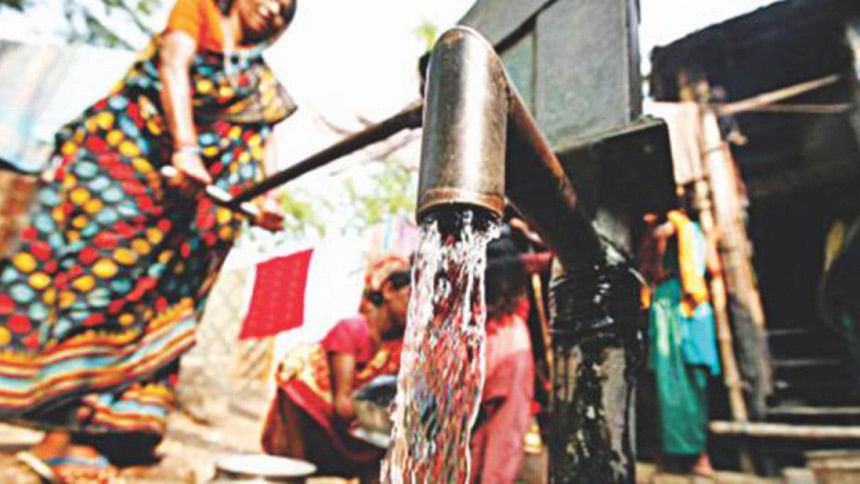Water that kills

Contaminated drinking water is a major cause of deaths globally. Last week, the World Health Organisation (WHO) unveiled the report "UN Water Global Analysis and Assessment of Sanitation and Drinking Water (GLAAS) 2017" which charts out the water and sanitation situation in 75 countries, and the news is not good. There are "2.4 billion people living without access to improved sanitation facilities, and nearly 700 million people not receiving their drinking-water from improved water sources." It is obvious that governments around the world are not spending enough to meet water and sanitation needs, and Bangladesh is no exception. Our government spends about USD 5 per capita on water and sanitation per year. And thanks to the sorry state of overpopulated cities, where municipal corporations are in no condition to supply safe drinking water to such huge numbers of people living in extremely congested areas, the casualty rate among children (under 5) dying due to diarrhoea has reached 45,000 per year.
We did not get here in a day. Over the last three decades, the capital city Dhaka has been a magnet for migration from rural areas. It is not simply a question of better employment opportunities, but has to do with land ownership patterns and the side effects of climate-induced changes that have wreaked havoc on traditional means of employment in rural areas. There was a time when this migration constituted workers destined primarily for the readymade garments industry, but we have witnessed the birth of new industries and different sectors over these few decades. We have also seen the rise of the non-manufacturing service sector. The net result of these changes is that major urban centres like Dhaka now boast mega-city population of more than 16 million people.
Human waste or faeces are going into the water supply, and this is putting people at risk of contracting cholera, dysentery, typhoid and polio. These are issues that policymakers must ponder upon when making national budgets and allocating resources for water and sanitation (WASH). Although the government budget for WASH has increased from USD 308 million to USD 548 million over FY2013 to FY2015, we have a very long way to go. The Department of Public Health Engineering, and Water Supply and Sewerage Authority of Dhaka, Chittagong, Khulna and Rajshahi are responsible for "water supply and sanitation facilities throughout the country. These five institutions alone reported a combined budget increase from Tk 20.2 to 30.3 billion (USD 259 million to USD 389 million) from 2013 to 2015." What comes through in the report is that despite countries like Bangladesh increasing WASH budgets, these measures are not having the desired impact. The fact is that there exists such a tremendous gap in financing to achieve the water supply, sanitation and hygiene targets set forth in SDG 6 that the capital investment needed will be at least three times the current investment levels.
While this is an average estimate, Bangladesh will have to take the WASH budget to well above the USD 1 billion mark from the current USD 500 million, and there lies a major hurdle: where is the money going to be found? As with other countries, the government has its own resources and external financing for the WASH budget, and according to the 2015 data, 23 percent of this came from external sources. "Globally, over USD 11 billion in ODA grants and loans (USD 7.4 billion), non-concessional loans/credits (USD 3.4 billion), and other funds (over USD 300 million) from high income countries (bilateral aid, multilateral development banks, NGOs, and private foundations) was disbursed (i.e. spent) on water and sanitation in 2015." Bangladesh featured ninth in the top recipients of development assistance for water and sanitation (greater than USD 100 million in disbursements in 2015), grants versus loans; and the majority of it came in the form of loans.
Despite finance from external sources and domestic mobilisation of resources, the challenge for policymakers remains on how to strike a balance between new investment (because the bulk of the budget come from domestic resources) to provide service to the "unserved" and recurring expenditure to sustain existing investments. Those challenges amplify as the coverage and quality of services increase, i.e. the increased costs for "staffing, electricity, parts, and supplies to operate and ensure the long-term viability of the existing systems and assets." The operational financing gap is usually covered through government subsidies. Cost recovery remains a major headache for countries like Bangladesh, where user tariffs are insufficient.
These are some of the problems we face. At the end of the day, as policymakers struggle to meet the ever-increasing demand for water, we can implement existing laws that make it very expensive for polluters to indiscriminately destroy existing water systems (both rural and urban).
The sheer greed of interest groups like real estate conglomerates to industry and individuals - all backed up by political clout - has literally transformed the geographical landscape of the country, where major sources of fresh water have been contaminated and continue to be contaminated and filled up. We are talking about major rivers that feed the capital city (Buriganga, Sitalakhya, Turagh, etc.), canals that once crisscrossed Dhaka, natural swamps and other water bodies - all these have suffered either encroachment or contamination thanks to the dumping of untreated industrial effluents or given way to housing estates. In the absence of strong and effective regulatory bodies that were supposed to protect us from such illegal activity, we are now facing serious public health hazards (as pointed out in the UN report) like losing 45,000 children under the age of five to diarrhoea.
There is also need for rationalising what it costs to get water to end users and what we, as consumers, are paying for that water, because lessening of government subsidy is needed so that those funds may go into improving the infrastructure to get more water to more people. These are undoubtedly tough decisions for any government to make, especially in the run-up to the general elections in 2019, but to do nothing is putting off a potential time bomb (in terms of health hazards) for millions of citizens, especially children who are most vulnerable to preventable diseases like diarrhoea.
The writer is Assistant Editor, The Daily Star.

 For all latest news, follow The Daily Star's Google News channel.
For all latest news, follow The Daily Star's Google News channel. 



Comments